php怎么调用python脚本?

php调用python脚本
起初是为了实现一个小需求,想要在JQuery执行的AJAX异步请求时在服务器端调用执行Python脚本。而Windows服务器端部署的WEB环境是Apache+PHP,在AJAX异步请求时根本不能直接调用Python脚本。
因为web开发语言是php而非Python的Django和Flask等开发框架。AJAX是可以调用执行服务器端的脚本文件,但它的本质仍是HTTP的请求。
所以就只能在HTTP请求中想办法调用Python脚本,也就在PHP程序中调用执行python脚本。
这里就要用到PHP的内置函数exec() 和system() ;
PHP的exec() 和system() 函数区别:
(1)system()
原型:string system (string command [, int return_var])
system()函数很其它语言中的差不多,它执行给定的命令,输出和返回结果。
(2)exec()
原型:string exec (string command [, string array [, int return_var]])
exec ()函数与system()类似,也执行给定的命令,但不输出结果,而是返回结果的最后一行。
可以看出两个函数的区别就是PHP在调用执行外部命令后,system()函数将执行的结果输出并返回给PHP程序。而 exec() 函数在调用执行外部命令后不会将结果输出,只是返回结果。
程序代码实现和对比:
(1)in.php程序使用exec()函数代码及解析:
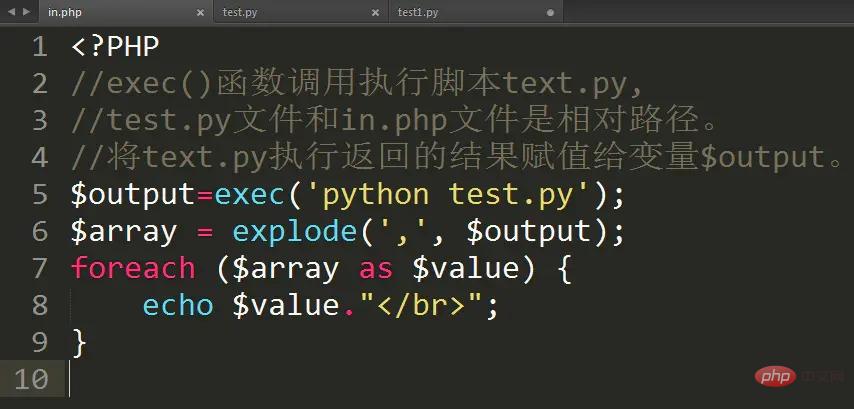
(2)test.py程序代码:
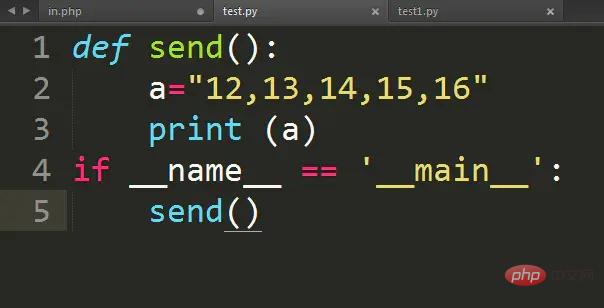
(3)PHP程序执行后效果1:

这样就利用exec()函数实现了对python脚本的调用,下面说一下将in.php程序中的exec()函数替换成system()函数后的执行效果。
(4)in.php程序使用system()函数代码及解析:
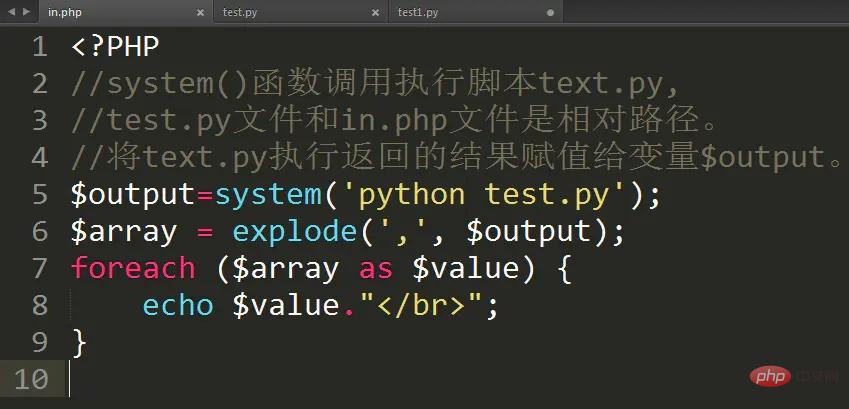
(5)PHP程序执行后效果2:
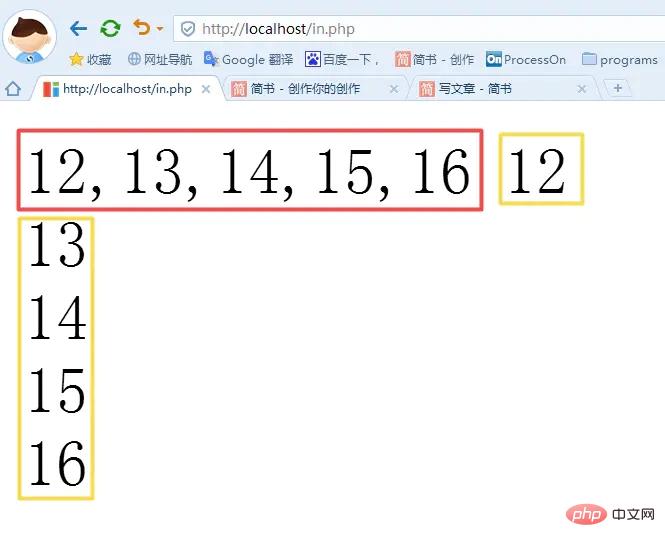
可以看出使用system()函数时,执行python程序时不但返回结果,而且将结果输出了,而exec()函数只是返回结果,没有输出。
扩展应用:(php web开发数据调用)
想要在网页上显示其它网站上的数据内容时,都需要网站提供数据的调用接口直接调用,如果没有接口,就需要用爬虫将数据爬回来后保存到数据库,在用程序从数据库中取出数据展示出来。(当然也可以用到php的curl库进行数据爬取后进行展示,但是个人认为在编程语言中做爬虫最简单并且强大的还是Python),而如果在PHP程序中直接调用python脚本进行爬虫,然后再将数据展示到网页上,这样就可以省去插入数据到数据库和从数据库读取数据的过程,这种做法对一些实时数据的爬取还是比较有用的,但是一定会影响网页的加载速度。下面将以前写的一个爬虫爬到的数据直接展示到web网页上供大家参考。
(1)php程序代码:
<?PHP $output=exec('python test1.py'); echo $output; ?>
(2)python爬虫代码:
import requests
import json
class WeatherSpider(object):
def __inti__(self):
pass
def request(self,url):
headers = {
'User-Agent':'Mozilla/5.0 (Windows NT 6.1; WOW64) AppleWebKit/537.36 (KHTML, like Gecko) Chrome/55.0.2883.87 Safari/537.36',
'Referer': 'http://www.weather.com.cn/weather40d/101060201.shtml'
}
return requests.get(url,headers=headers)
def create_url(self):
year = '2016'
for i in range(1,2):
month = str(i) if i > 9 else "0" + str(i)
url = "http://d1.weather.com.cn/calendar_new/" + year + "/101060201_" + year + month + ".html"
self.get_data(url)
def get_data(self,url):
respone = self.request(url).content
json_str = respone.decode(encoding='utf-8')[11:]
weathers = json.loads(json_str)
data = ""
for weather in weathers:
data = data+weather.get('date')+'星期'+weather.get('wk')+weather.get('hmax')+weather.get('hmin')+weather.get('hgl')+"<br>"
print (data)
if __name__ == '__main__':
jl_weather = WeatherSpider()
jl_weather.create_url()(3)web网页爬虫展示:
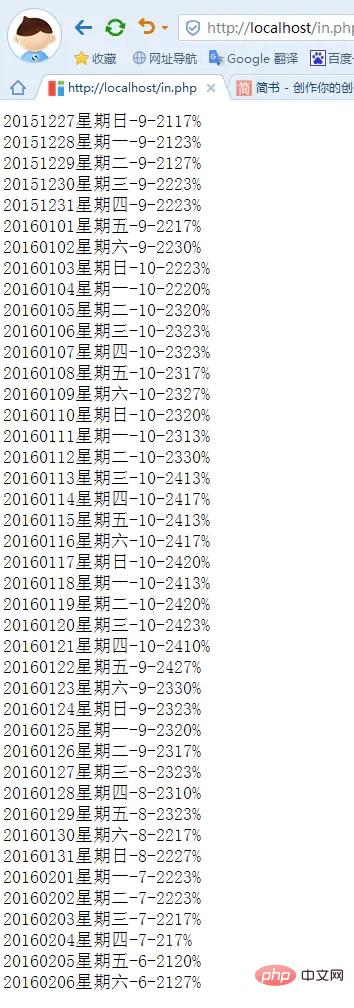
推荐教程:PHP视频教程

Hot AI Tools

Undresser.AI Undress
AI-powered app for creating realistic nude photos

AI Clothes Remover
Online AI tool for removing clothes from photos.

Undress AI Tool
Undress images for free

Clothoff.io
AI clothes remover

Video Face Swap
Swap faces in any video effortlessly with our completely free AI face swap tool!

Hot Article

Hot Tools

Notepad++7.3.1
Easy-to-use and free code editor

SublimeText3 Chinese version
Chinese version, very easy to use

Zend Studio 13.0.1
Powerful PHP integrated development environment

Dreamweaver CS6
Visual web development tools

SublimeText3 Mac version
God-level code editing software (SublimeText3)

Hot Topics
 PHP and Python: Different Paradigms Explained
Apr 18, 2025 am 12:26 AM
PHP and Python: Different Paradigms Explained
Apr 18, 2025 am 12:26 AM
PHP is mainly procedural programming, but also supports object-oriented programming (OOP); Python supports a variety of paradigms, including OOP, functional and procedural programming. PHP is suitable for web development, and Python is suitable for a variety of applications such as data analysis and machine learning.
 Choosing Between PHP and Python: A Guide
Apr 18, 2025 am 12:24 AM
Choosing Between PHP and Python: A Guide
Apr 18, 2025 am 12:24 AM
PHP is suitable for web development and rapid prototyping, and Python is suitable for data science and machine learning. 1.PHP is used for dynamic web development, with simple syntax and suitable for rapid development. 2. Python has concise syntax, is suitable for multiple fields, and has a strong library ecosystem.
 Why Use PHP? Advantages and Benefits Explained
Apr 16, 2025 am 12:16 AM
Why Use PHP? Advantages and Benefits Explained
Apr 16, 2025 am 12:16 AM
The core benefits of PHP include ease of learning, strong web development support, rich libraries and frameworks, high performance and scalability, cross-platform compatibility, and cost-effectiveness. 1) Easy to learn and use, suitable for beginners; 2) Good integration with web servers and supports multiple databases; 3) Have powerful frameworks such as Laravel; 4) High performance can be achieved through optimization; 5) Support multiple operating systems; 6) Open source to reduce development costs.
 PHP and Python: A Deep Dive into Their History
Apr 18, 2025 am 12:25 AM
PHP and Python: A Deep Dive into Their History
Apr 18, 2025 am 12:25 AM
PHP originated in 1994 and was developed by RasmusLerdorf. It was originally used to track website visitors and gradually evolved into a server-side scripting language and was widely used in web development. Python was developed by Guidovan Rossum in the late 1980s and was first released in 1991. It emphasizes code readability and simplicity, and is suitable for scientific computing, data analysis and other fields.
 PHP: An Introduction to the Server-Side Scripting Language
Apr 16, 2025 am 12:18 AM
PHP: An Introduction to the Server-Side Scripting Language
Apr 16, 2025 am 12:18 AM
PHP is a server-side scripting language used for dynamic web development and server-side applications. 1.PHP is an interpreted language that does not require compilation and is suitable for rapid development. 2. PHP code is embedded in HTML, making it easy to develop web pages. 3. PHP processes server-side logic, generates HTML output, and supports user interaction and data processing. 4. PHP can interact with the database, process form submission, and execute server-side tasks.
 PHP vs. Python: Use Cases and Applications
Apr 17, 2025 am 12:23 AM
PHP vs. Python: Use Cases and Applications
Apr 17, 2025 am 12:23 AM
PHP is suitable for web development and content management systems, and Python is suitable for data science, machine learning and automation scripts. 1.PHP performs well in building fast and scalable websites and applications and is commonly used in CMS such as WordPress. 2. Python has performed outstandingly in the fields of data science and machine learning, with rich libraries such as NumPy and TensorFlow.
 PHP's Impact: Web Development and Beyond
Apr 18, 2025 am 12:10 AM
PHP's Impact: Web Development and Beyond
Apr 18, 2025 am 12:10 AM
PHPhassignificantlyimpactedwebdevelopmentandextendsbeyondit.1)ItpowersmajorplatformslikeWordPressandexcelsindatabaseinteractions.2)PHP'sadaptabilityallowsittoscaleforlargeapplicationsusingframeworkslikeLaravel.3)Beyondweb,PHPisusedincommand-linescrip
 PHP and the Web: Exploring its Long-Term Impact
Apr 16, 2025 am 12:17 AM
PHP and the Web: Exploring its Long-Term Impact
Apr 16, 2025 am 12:17 AM
PHP has shaped the network over the past few decades and will continue to play an important role in web development. 1) PHP originated in 1994 and has become the first choice for developers due to its ease of use and seamless integration with MySQL. 2) Its core functions include generating dynamic content and integrating with the database, allowing the website to be updated in real time and displayed in personalized manner. 3) The wide application and ecosystem of PHP have driven its long-term impact, but it also faces version updates and security challenges. 4) Performance improvements in recent years, such as the release of PHP7, enable it to compete with modern languages. 5) In the future, PHP needs to deal with new challenges such as containerization and microservices, but its flexibility and active community make it adaptable.






